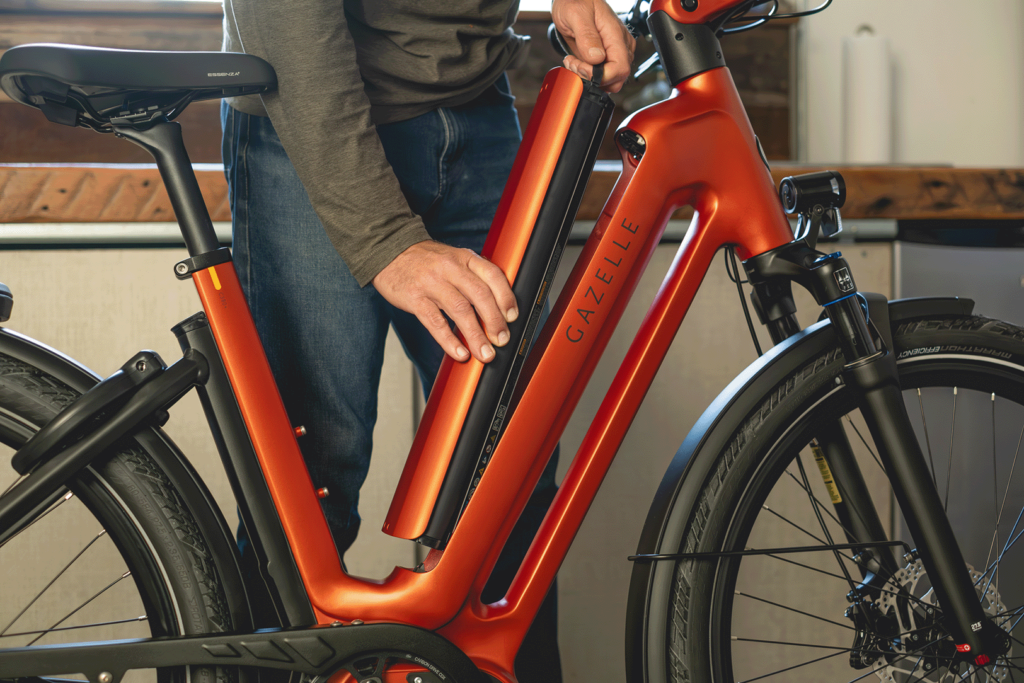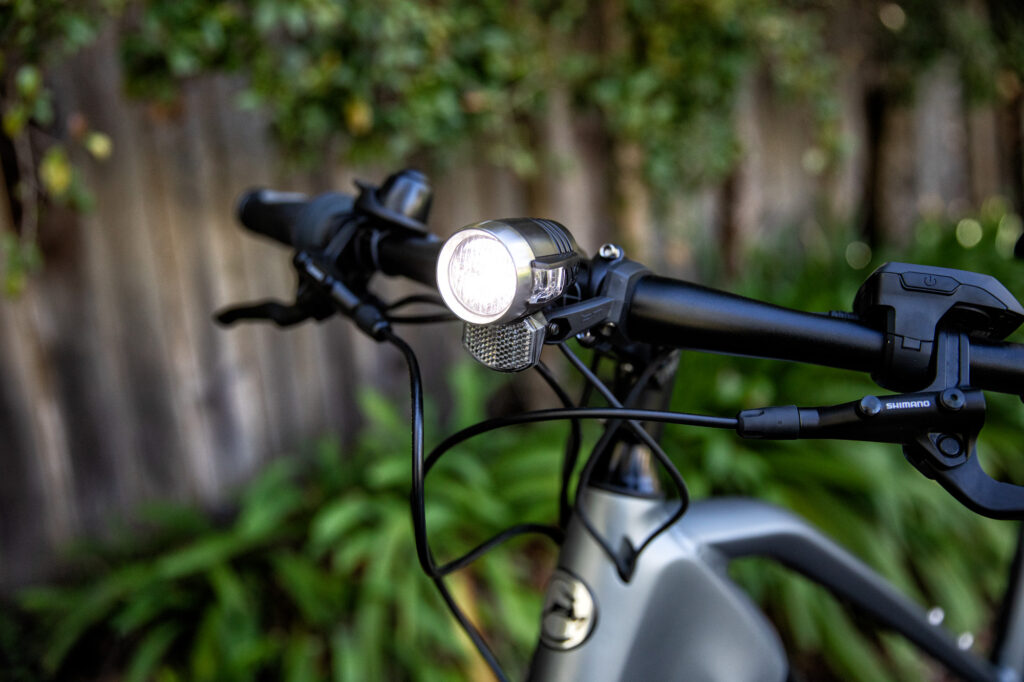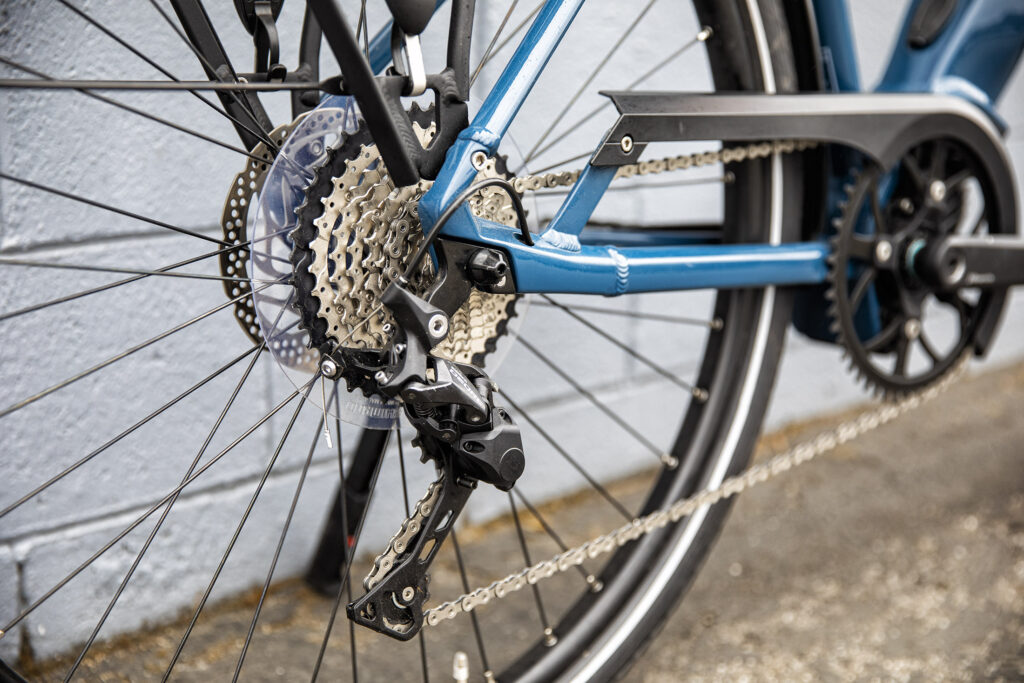As the days grow shorter and the temperatures drop, many fair weather cyclists store their bikes away for the winter, but not you. Your Gazelle ebike is designed to handle even the harshest of Dutch winters so you get to enjoy year-round rides! Winter riding is different from summer cycling, but with the right precautions, your ebike can handle the elements and keep you moving even when the snow flies.
Here’s a few tips to help you get your Gazelle ebike ready for winter cycling, plus some advice to keep you safe, comfortable, and your bike performing at its best.
1. Prep Your eBike for Cold Weather
Cold temperatures can affect both your ebike’s performance and your comfort, so it’s essential to ensure your bike is in top condition before heading out.

Battery Care
The battery is one of the most sensitive components of an ebike in winter. Cold weather can cause the battery to charge more slowly, drain more quickly, and even reduce its lifespan if not properly maintained. Here are some tips for battery care:
- Keep it warm: Always store your battery indoors when not in use. If you need to remove the battery for charging, avoid leaving it in a cold garage or shed. Ideally, charge it in a temperature range of 50°F to 70°F (10°C to 20°C) for optimal performance.
- Charge before it gets too low: Unlike in warmer weather, where you may have some leeway with charging schedules, in the winter, try not to let your battery get too low before recharging. A battery that’s close to empty in cold weather can suffer from reduced capacity.
- Monitor battery health: If you notice a significant drop in range or power, it could be due to cold temperatures or battery aging. Consider carrying a spare battery for longer rides or when commuting in extreme conditions.
Check the Tires
Cold weather can lead to more slippery roads, and with snow and ice on the ground, tire choice becomes crucial for safe and efficient riding. Here’s how to prepare:
- Keep an eye on your PSI: Cold weather can lower tire pressure, making it essential to check and adjust pressure regularly. Running your tires at about 5-10 PSI lower than usual can help to improve traction on slippery surfaces. For more tire talk, check out our blog on PSI.
- Select a model with wider tires: Some of our models come with skinnier tires than others, so if you live in a climate with more pronounced winter conditions and plan to ride through winter, you may want to select a model like the Avignon, Eclipse, or our newer Medeo T9 ebikes that feature wider tires for better grip and stability in all conditions. Larger tires distribute your weight more evenly and help you stay upright on snowy or icy surfaces.
- Consider studded tires: If you’re planning to ride through icy conditions regularly, studded tires are an excellent investment. These tires have metal spikes embedded in the rubber, which can help grip icy surfaces for safer riding.
2. Dress for Success: Gear Up for the Elements
Winter cycling requires a bit more preparation on your end to stay warm, comfortable, and safe.

Layer Up
Layering is key to staying comfortable during winter rides. Here’s how to dress for success:
- Base layer: Start with a moisture-wicking base layer to keep sweat off your skin. Merino wool or synthetic fabrics are ideal.
- Mid-layer: Add an insulating layer, like a fleece or down jacket, to retain body heat without causing you to overheat.
- Outer layer: Your outer layer should be windproof and waterproof to protect you from snow, rain, and the chill of the wind. Look for a high-quality cycling jacket or a rain cape that’s breathable.
- Gloves and socks: Cold hands and feet can quickly ruin a ride, so invest in insulated gloves and warm, moisture-wicking socks. Consider battery-heated gloves for extra warmth.
- Headgear: A thermal cap or headband under your helmet can help keep your ears warm. A full-face mask or balaclava is great for protecting your face from freezing wind and snow.
Visibility is Key
Winter days are shorter, and poor weather can make it harder for drivers to see you. Be sure to:

- Wear bright, reflective clothing: High-visibility jackets, vests, and accessories (like reflective ankle straps) will make you more noticeable in low-light conditions.
- Use lights: Always ride with the ebike’s front and rear lights turned on, even during daylight hours, to increase your visibility. A powerful front light will help you see where you’re going, while a red rear light will make you visible to others on the road.
3. Ride Smart: Adjust Your Riding Style
Winter conditions demand more care and attention, especially when it comes to your riding technique. Follow these tips to stay safe and comfortable:
- Slow down: Wet, icy, or snowy roads can be slippery, so give yourself extra stopping distance and reduce your speed. In many cases, the added torque of your ebike’s motor can make it easy to accelerate quickly, so be mindful of your power output.
- Anticipate obstacles: Snow and ice can conceal potholes, gravel, and other road hazards. Look ahead and steer around them when possible to avoid sudden stops or spills.
- Avoid sudden movements: Sudden braking or sharp turns can lead to loss of traction, so try to make your movements smooth and gradual.
Use pedal-assist wisely: While your ebike’s pedal-assist function can help with hills and wind, be careful when using high levels of assist on slippery surfaces, as it can cause wheel spin.
4. Maintain Your eBike for Winter Conditions
Your ebike will require more maintenance in the winter months, not only to ensure that it performs well but to prevent winter-specific issues.

Keep It Clean
Winter riding can bring a lot of grime, salt, and road debris onto your bike. Clean your ebike after every ride, paying particular attention to:
- Frame and drivetrain: Clean off any salt or road grime that can lead to rust or wear over time. Use a mild cleanser such as “Muc-off” and water to clean the frame, and be sure to dry it thoroughly.
- Chain maintenance: The chain is particularly susceptible to corrosion in winter, so keep it lubricated with a high-quality, wet-weather lubricant. Make sure to clean the chain regularly, removing any dirt and excess lubricant that could build up.
- Brake check: Cold weather can affect braking performance, so check your brakes before each ride. Make sure they are reactive and working smoothly, especially in snowy or icy conditions.
Inspect Before You Ride
If all else fails, use this checklist before your rides to cover your ebike bases.
- Tire pressure and condition
- Battery charge level and temperature
- Brake function
- Chain and drivetrain cleanliness and lubrication
- Lights and visibility accessories
5. Be Prepared for the Unexpected

Winter weather can be unpredictable, so it’s always a good idea to carry a few essentials just in case:
- Spare gloves, socks, or hat in case your current ones get wet.
- A repair kit with essentials like tire levers, patch kit, and a mini pump.
- Waterproof phone case or a way to protect your phone from snow and moisture.
Emergency snacks like an energy bar, in case you need a boost during a long ride.
Happy winter riding!
By taking these steps, you can make the most of your Gazelle ebike throughout the winter season. With the right preparation, winter rides are just as enjoyable as summer cruising. Enjoy crisp air, peaceful landscapes, and the satisfaction of getting to your destination without a car. So embrace the ride, the only bad weather is the one you’re not prepared for!



